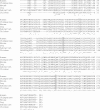Identification of Two Novel HOXB13 Germline Mutations in Portuguese Prostate Cancer Patients
- PMID: 26176944
- PMCID: PMC4503425
- DOI: 10.1371/journal.pone.0132728
Identification of Two Novel HOXB13 Germline Mutations in Portuguese Prostate Cancer Patients
Abstract
The HOXB13 germline variant G84E (rs138213197) was recently described in men of European descent, with the highest prevalence in Northern Europe. The G84E mutation has not been found in patients of African or Asian ancestry, which may carry other HOXB13 variants, indicating allelic heterogeneity depending on the population. In order to gain insight into the full scope of coding HOXB13 mutations in Portuguese prostate cancer patients, we decided to sequence the entire coding region of the HOXB13 gene in 462 early-onset or familial/hereditary cases. Additionally, we searched for somatic HOXB13 mutations in 178 prostate carcinomas to evaluate their prevalence in prostate carcinogenesis. Three different patients were found to carry in their germline DNA two novel missense variants, which were not identified in 132 control subjects. Both variants are predicted to be deleterious by different in silico tools. No somatic mutations were found. These findings further support the hypothesis that different rare HOXB13 mutations may be found in different ethnic groups. Detection of mutations predisposing to prostate cancer may require re-sequencing rather than genotyping, as appropriate to the population under investigation.
Conflict of interest statement
Figures




Similar articles
-
Mutation HOXB13 c.853delT in Martinican prostate cancer patients.Prostate. 2020 May;80(6):463-470. doi: 10.1002/pros.23960. Epub 2020 Feb 10. Prostate. 2020. PMID: 32040869
-
Prevalence of the HOXB13 G84E germline mutation in British men and correlation with prostate cancer risk, tumour characteristics and clinical outcomes.Ann Oncol. 2015 Apr;26(4):756-761. doi: 10.1093/annonc/mdv004. Epub 2015 Jan 16. Ann Oncol. 2015. PMID: 25595936
-
A population-based assessment of germline HOXB13 G84E mutation and prostate cancer risk.Eur Urol. 2014 Jan;65(1):169-76. doi: 10.1016/j.eururo.2012.07.027. Epub 2012 Jul 20. Eur Urol. 2014. PMID: 22841674
-
Homeobox B13 G84E Mutation and Prostate Cancer Risk.Eur Urol. 2019 May;75(5):834-845. doi: 10.1016/j.eururo.2018.11.015. Epub 2018 Dec 8. Eur Urol. 2019. PMID: 30527799 Free PMC article.
-
Germline homeobox B13 (HOXB13) G84E mutation and prostate cancer risk in European descendants: a meta-analysis of 24,213 cases and 73, 631 controls.Eur Urol. 2013 Jul;64(1):173-6. doi: 10.1016/j.eururo.2013.03.007. Epub 2013 Mar 14. Eur Urol. 2013. PMID: 23518396 Review. No abstract available.
Cited by
-
Identification of Germline Genetic Variants that Increase Prostate Cancer Risk and Influence Development of Aggressive Disease.Cancers (Basel). 2021 Feb 12;13(4):760. doi: 10.3390/cancers13040760. Cancers (Basel). 2021. PMID: 33673083 Free PMC article. Review.
-
Targeted next generation sequencing identifies functionally deleterious germline mutations in novel genes in early-onset/familial prostate cancer.PLoS Genet. 2018 Apr 16;14(4):e1007355. doi: 10.1371/journal.pgen.1007355. eCollection 2018 Apr. PLoS Genet. 2018. PMID: 29659569 Free PMC article.
-
Conference report from the 2015 OECI Oncology Days, Portugal, 22-24 June-tumour heterogeneity and next generation sequencing: morphology and technology.Ecancermedicalscience. 2015 Aug 19;9:565. doi: 10.3332/ecancer.2015.565. eCollection 2015. Ecancermedicalscience. 2015. PMID: 26316886 Free PMC article.
-
HOXB13 expression and promoter methylation as a candidate biomarker in gastric cancer.Oncol Lett. 2018 Jun;15(6):8833-8840. doi: 10.3892/ol.2018.8371. Epub 2018 Mar 29. Oncol Lett. 2018. PMID: 29928325 Free PMC article.
-
Prostate Cancer Genomics: Recent Advances and the Prevailing Underrepresentation from Racial and Ethnic Minorities.Int J Mol Sci. 2018 Apr 22;19(4):1255. doi: 10.3390/ijms19041255. Int J Mol Sci. 2018. PMID: 29690565 Free PMC article. Review.
References
-
- Crawford ED. Epidemiology of prostate cancer. Urology. 2003;62:3–12. - PubMed
-
- Simard J, Dumont M, Soucy P, Labrie F. Perspective: Prostate cancer susceptibility genes. Endocrinology. 2002;143:2029–40. - PubMed
-
- Bruner DW, Moore D, Parlanti A, Dorgan J, Engstrom P. Relative risk of prostate cancer for men with affected relatives: systematic review and meta-analysis. Int. J. Cancer. 2003;107:797–803. - PubMed
Publication types
MeSH terms
Substances
LinkOut - more resources
Full Text Sources
Other Literature Sources
Medical

